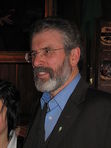Gerry Adams's Blog, page 32
April 4, 2019
A Referendum on Unity is coming
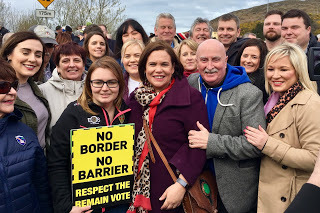
Last November, a few days after the Withdrawal Treaty was published, and on the eve of British Prime Minister Theresa May travelling to Brussels to sign it, Boris Johnson arrived in the North. He was in Belfast to address the DUP’s annual party conference; the night after the British Chancellor Philip Hammond attended it. Johnson entered the Crowne Plaza amid great fanfare. The visits were a show of solidarity and plamas by English Tories to keep the DUP on board the partnership arrangements. There was a standing ovation and lots of photos of a beaming Boris hugging Arlene. Smiles all around. Johnson told an enraptured DUP audience that the British government was “on the verge of making a historic mistake.” He told them: “We need to junk the backstop.”
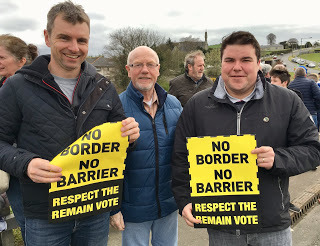 Johnson told the DUP conference exactly what it wanted to hear. Just like Jacob Rees Mogg. In recent weeks as the debacle of a succession of failed Westminster votes and defeats for the May government unfolded, the Tory backbencher, and leader of the right wing European Research Group (ERG), told every media outlet who asked that his vote on the backstop and the Withdrawal Treaty was entirely dependent upon on the DUP. Using emotive and divisive rhetoric Mogg claimed that the Withdrawal Treaty would leave Britain a vassal state to the EU. He said: “It is not something I would vote for, nor is it what the British people voted for.” In his scathing criticism of Theresa May he accused her of giving Brussels “everything they want … It’s not so much a vassal state anymore as a slave state.” The DUP were delighted. Last week it all came unstuck. Johnson and Mogg both u-turned, abandoned their friends in the DUP and walked through the lobby in Westminster in support of May’s Withdrawal Treaty. Could Johnson’s ambition to be the next leader of the Conservative Party have had anything to do with this volte-face? Almost 100 years ago Edward Carson, the father of Ulster Unionism, was faced with a similar betrayal. Addressing the British House of Lords in December 1921, on the issue of the Treaty and the Partition of Ireland, Carson was contemptuous of the British government’s willingness to negotiate with the “Sinn Feiners”. Carson said: “What a fool I was. I was only a puppet, and so was Ulster, and so was Ireland, in the political game that was to get the Conservative Party into power. And of all the men in my experience that I think are the most loathsome it is those who will sell their friends for the purpose of conciliating their enemies, and, perhaps, still worse, the men who climb up a ladder into power of which even I may have been part of a humble rung, and then, when they have got into power, kick the ladder away without any concern for the pain, or injury, or mischief, or damage that they do to those who have helped them to gain power”.Carson’s words echo down through the decades as a warning to unionist leaders that the real threat to political unionism comes from English Tories who are prepared to betray unionists in Ireland if English interests require it.
Johnson told the DUP conference exactly what it wanted to hear. Just like Jacob Rees Mogg. In recent weeks as the debacle of a succession of failed Westminster votes and defeats for the May government unfolded, the Tory backbencher, and leader of the right wing European Research Group (ERG), told every media outlet who asked that his vote on the backstop and the Withdrawal Treaty was entirely dependent upon on the DUP. Using emotive and divisive rhetoric Mogg claimed that the Withdrawal Treaty would leave Britain a vassal state to the EU. He said: “It is not something I would vote for, nor is it what the British people voted for.” In his scathing criticism of Theresa May he accused her of giving Brussels “everything they want … It’s not so much a vassal state anymore as a slave state.” The DUP were delighted. Last week it all came unstuck. Johnson and Mogg both u-turned, abandoned their friends in the DUP and walked through the lobby in Westminster in support of May’s Withdrawal Treaty. Could Johnson’s ambition to be the next leader of the Conservative Party have had anything to do with this volte-face? Almost 100 years ago Edward Carson, the father of Ulster Unionism, was faced with a similar betrayal. Addressing the British House of Lords in December 1921, on the issue of the Treaty and the Partition of Ireland, Carson was contemptuous of the British government’s willingness to negotiate with the “Sinn Feiners”. Carson said: “What a fool I was. I was only a puppet, and so was Ulster, and so was Ireland, in the political game that was to get the Conservative Party into power. And of all the men in my experience that I think are the most loathsome it is those who will sell their friends for the purpose of conciliating their enemies, and, perhaps, still worse, the men who climb up a ladder into power of which even I may have been part of a humble rung, and then, when they have got into power, kick the ladder away without any concern for the pain, or injury, or mischief, or damage that they do to those who have helped them to gain power”.Carson’s words echo down through the decades as a warning to unionist leaders that the real threat to political unionism comes from English Tories who are prepared to betray unionists in Ireland if English interests require it.
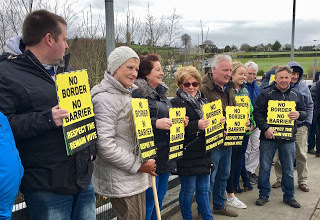 Thatcher – the Iron Lady - demonstrated that same calculating approach when, in November 1985, she signed the Anglo-Irish Agreement with the Irish government against the expressed wishes of political unionism. Ian Paisley led tens of thousands in mass demonstrations to oppose an Agreement that appeared to give the Irish government some sort of role in the North. It was his “Never, Never, Never” moment. Unionists felt betrayed. But Thatcher believed that the tokenism of the Agreement, with its objective of bolstering the SDLP against the electoral advance of Sinn Féin, were worth it. British interests again trumped unionist interests.Last Friday, at two separate ‘Leave’ rallies outside Westminster, one of which was led by two loyalist bands from Scotland playing The Sash and other Orange songs, Ian Paisley Jnr tried to emulate his father. He treated the crowd to ‘No Surrender’ and claimed that: “Ahead of us stands the sunny uplands of Freedom! Do not let any government put upon you a Withdrawal Agreement that cuts our great nation in two”.
Thatcher – the Iron Lady - demonstrated that same calculating approach when, in November 1985, she signed the Anglo-Irish Agreement with the Irish government against the expressed wishes of political unionism. Ian Paisley led tens of thousands in mass demonstrations to oppose an Agreement that appeared to give the Irish government some sort of role in the North. It was his “Never, Never, Never” moment. Unionists felt betrayed. But Thatcher believed that the tokenism of the Agreement, with its objective of bolstering the SDLP against the electoral advance of Sinn Féin, were worth it. British interests again trumped unionist interests.Last Friday, at two separate ‘Leave’ rallies outside Westminster, one of which was led by two loyalist bands from Scotland playing The Sash and other Orange songs, Ian Paisley Jnr tried to emulate his father. He treated the crowd to ‘No Surrender’ and claimed that: “Ahead of us stands the sunny uplands of Freedom! Do not let any government put upon you a Withdrawal Agreement that cuts our great nation in two”.
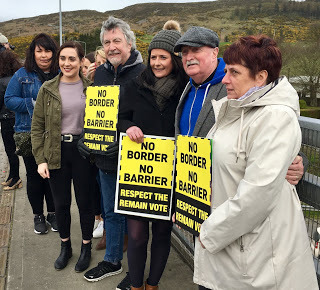 Almost two years ago after Theresa May’s disastrous general election saw the Conservatives lose seats and enter into an alliance with the DUP, I warned then that it would be a relatively short-lived experiment and that there would be tears at the end of it. In the midst of the back-stabbing and schisms at Westminster that is a daily feature of British news, the British political system is now more divided than at any time in its recent history. It is also increasingly clear with every day that passes, and with each report that is published, that Brexit – whether hard or soft - poses a huge threat to the two economies on this island. Brexit threatens thousands of jobs, our farming and agri-food industry, the human and civil rights of citizens, and the Good Friday Agreement. In addition, the British government is using this crisis to undermine the rights of Irish citizens living in the North - enshrined in the Good Friday Agreement – by trying to force British citizenship on to us. This is unacceptable. There is a huge onus on the Irish government to stand up to British jingoism and Tory partisan policies. It must defend the rights and entitlements of all citizens living in the North that are a fundamental part of the architecture of the Good Friday Agreement.
Almost two years ago after Theresa May’s disastrous general election saw the Conservatives lose seats and enter into an alliance with the DUP, I warned then that it would be a relatively short-lived experiment and that there would be tears at the end of it. In the midst of the back-stabbing and schisms at Westminster that is a daily feature of British news, the British political system is now more divided than at any time in its recent history. It is also increasingly clear with every day that passes, and with each report that is published, that Brexit – whether hard or soft - poses a huge threat to the two economies on this island. Brexit threatens thousands of jobs, our farming and agri-food industry, the human and civil rights of citizens, and the Good Friday Agreement. In addition, the British government is using this crisis to undermine the rights of Irish citizens living in the North - enshrined in the Good Friday Agreement – by trying to force British citizenship on to us. This is unacceptable. There is a huge onus on the Irish government to stand up to British jingoism and Tory partisan policies. It must defend the rights and entitlements of all citizens living in the North that are a fundamental part of the architecture of the Good Friday Agreement.
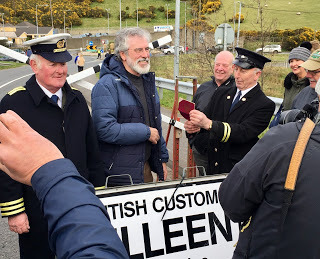 At the weekend thousands turned out at a series of events along the border, organised by the Border Communities Against Brexit, to protest at Brexit. They were good natured protests. But there is a clear determination on the part of the border communities not to see the clock turned back to the days of border checkpoints and disruption of community and family life.There is now hardly a day passes without the issue of a referendum on Irish Unity and of a United Ireland being part of the discourse around Brexit. Former President Mary McAleese made a thoughtful speech last week on this and related issues. Reunification is now a mainstream topic. A referendum on Irish Unity will happen.The fiasco that is Brexit, and the Tory and DUP shambles of a response to it, have together opened up a willingness for a real and meaningful conversation on Unity. It is an opportunity that must be grasped and not ignored by the Irish government. The debate is happening anyway. Dublin needs to embrace it and face the future. A united and fair future for everyone on the island of Ireland. So, let’s prepare for the referendum”.
At the weekend thousands turned out at a series of events along the border, organised by the Border Communities Against Brexit, to protest at Brexit. They were good natured protests. But there is a clear determination on the part of the border communities not to see the clock turned back to the days of border checkpoints and disruption of community and family life.There is now hardly a day passes without the issue of a referendum on Irish Unity and of a United Ireland being part of the discourse around Brexit. Former President Mary McAleese made a thoughtful speech last week on this and related issues. Reunification is now a mainstream topic. A referendum on Irish Unity will happen.The fiasco that is Brexit, and the Tory and DUP shambles of a response to it, have together opened up a willingness for a real and meaningful conversation on Unity. It is an opportunity that must be grasped and not ignored by the Irish government. The debate is happening anyway. Dublin needs to embrace it and face the future. A united and fair future for everyone on the island of Ireland. So, let’s prepare for the referendum”.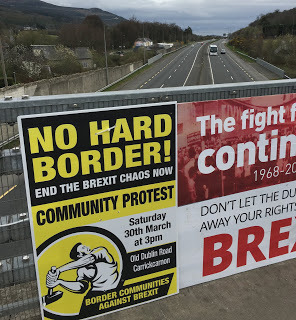
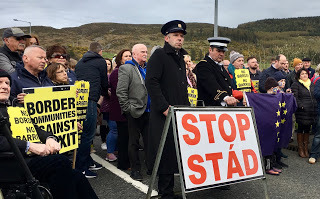
Published on April 04, 2019 05:32
March 29, 2019
Áras Uí Chonghaile – A world class centre for Belfast
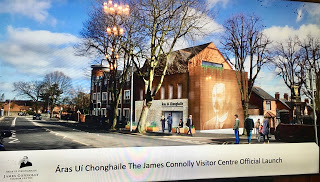
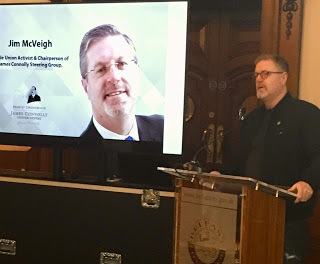 Jim McVeigh opening the event “Comrades, Brothers and Sisters,
Jim McVeigh opening the event “Comrades, Brothers and Sisters,I have wonderful news! Our comrade James Connolly, the General Secretary of our great union, the ITGWU, is returning to Belfast on the 19th April. He and his family will take up residence in 374 Falls Road.
Come and welcome him. Come and listen to his speeches. Come and read his insightful publications.
He comes to Belfast to lead us and unite the working class, not as Catholics and Protestants, not as Nationalist and Unionist but as Belfast workers united.
He comes to lead us in the glorious struggle for Socialism”.With these stirring words, Jim McVeigh, Trade Union activist and Chair of the James Connolly Association, commenced the formal launch of Áras Uí Chonghaile – the James Connolly Visitor Centre – at Belfast City Hall last week. The centre itself will be opened on April 19thwith a pageant along the Falls Road from Conway Mill, where 100 years ago Connolly helped organize the predominantly female workforce, to Áras Uí Chonghaile. Fáilte Feirste Thiar – the west Belfast Tourist Board – is the lead agency responsible for the development and administration of Áras Uí Chonghaile. The new centre is only a couple of hundred yards from the Connolly family home at 1 Glenalina Terrace (420 Falls Road).
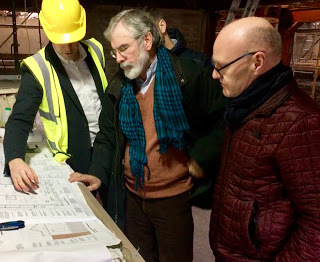 With Fergal Rainey shoing Paul Maskey MP and mise the plansThe last time I was in 374 Falls Road it was a shop and post office. A couple of weeks ago when I visited it again the noise was intense. Workmen were busy hammering and drilling and brickies were hard at work carefully putting the new front wall in place. Electricians were running wire. New stairs were being erected. The huge sheets of steel, which will form the side elevation of the building with the image of James Connolly emblazoned on them, had still to be erected. They had still not gone through the acid wash and weathering necessary for them to develop the characteristic rust-like appearance which will soon dominate that part of the Falls Road. That process was only completed last week.
With Fergal Rainey shoing Paul Maskey MP and mise the plansThe last time I was in 374 Falls Road it was a shop and post office. A couple of weeks ago when I visited it again the noise was intense. Workmen were busy hammering and drilling and brickies were hard at work carefully putting the new front wall in place. Electricians were running wire. New stairs were being erected. The huge sheets of steel, which will form the side elevation of the building with the image of James Connolly emblazoned on them, had still to be erected. They had still not gone through the acid wash and weathering necessary for them to develop the characteristic rust-like appearance which will soon dominate that part of the Falls Road. That process was only completed last week.
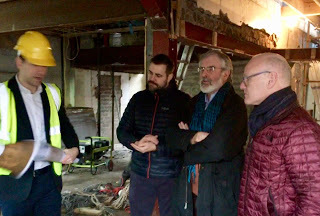 But Fergal Rainey of McGurk Architects is confident that the entire Áras will be completed for the April 19thopening.The purpose of the £1.4 million centre is to conserve the heritage of James Connolly and the key role he played in Irish history, the struggle for freedom and the Labour Movement. It will be a world class visitor centre exploring the life of Connolly; with a unique interactive exhibition; a library of writing by and about Connolly; a multi-functional conference facility, and an all year round programme of engagement with communities, schools and visitors and a bialann. Redhead Exhibitions has brought its considerable experience to the project to ensure that the exhibition is of world class standard. Áras Uí Chonghaile will also hold historical objects relating to Connolly, photographs and original publications, including photos never seen before. There will also be a 1935 hardback edition of a book written by Nora Connolly O’Brien, Connolly’s daughter.Incidently, I lent my copy of this fine book to a friend to help his daughter in a school project. I haven’t got it back Gary.The centre has been funded by Belfast City Council and with the financial and logistical support of the American Trade Union Movement under the leadership of Terry O’Sullivan of Laborers International Union of North America and John Samuelsson of the Transport Workers Union.
But Fergal Rainey of McGurk Architects is confident that the entire Áras will be completed for the April 19thopening.The purpose of the £1.4 million centre is to conserve the heritage of James Connolly and the key role he played in Irish history, the struggle for freedom and the Labour Movement. It will be a world class visitor centre exploring the life of Connolly; with a unique interactive exhibition; a library of writing by and about Connolly; a multi-functional conference facility, and an all year round programme of engagement with communities, schools and visitors and a bialann. Redhead Exhibitions has brought its considerable experience to the project to ensure that the exhibition is of world class standard. Áras Uí Chonghaile will also hold historical objects relating to Connolly, photographs and original publications, including photos never seen before. There will also be a 1935 hardback edition of a book written by Nora Connolly O’Brien, Connolly’s daughter.Incidently, I lent my copy of this fine book to a friend to help his daughter in a school project. I haven’t got it back Gary.The centre has been funded by Belfast City Council and with the financial and logistical support of the American Trade Union Movement under the leadership of Terry O’Sullivan of Laborers International Union of North America and John Samuelsson of the Transport Workers Union.
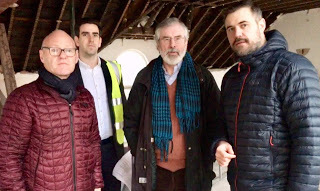 Paul Maskey; Fergal Rainey, mise and Harry Connolly of Failte Feirste ThiarÁras Uí Chonghaile will be a celebration of the life and times of Connolly from his birth in Edinburgh in 1868 to his execution by the British in May 1916. It will explore Connolly’s work as a trade union activist; his writings; his travels in Ireland, Britain and the USA; the establishment of the Irish Citizen Army and the Dublin Lockout; and his life in Belfast organizing the Dockers and Linen workers.His Belfast days did much to shape Connolly’s politics and his socialism. He was appointed Belfast Branch Secretary and Ulster Organiser of the Irish Transport and General Workers Union with is office in Corporation Street. He immediately set about organizing the Dock and Linen workers. Their conditions of work 100 years ago were hellish. The first strike he organized was by the Dockers. They were paid a penny per ton for shoveling iron ore. This was a quarter of the rate for Dockers doing he same work in Britain. Connolly organized a non-sectarian band which paraded through the streets collecting money for the strike fund. The strike ended when the worker’s pay was increased.
Paul Maskey; Fergal Rainey, mise and Harry Connolly of Failte Feirste ThiarÁras Uí Chonghaile will be a celebration of the life and times of Connolly from his birth in Edinburgh in 1868 to his execution by the British in May 1916. It will explore Connolly’s work as a trade union activist; his writings; his travels in Ireland, Britain and the USA; the establishment of the Irish Citizen Army and the Dublin Lockout; and his life in Belfast organizing the Dockers and Linen workers.His Belfast days did much to shape Connolly’s politics and his socialism. He was appointed Belfast Branch Secretary and Ulster Organiser of the Irish Transport and General Workers Union with is office in Corporation Street. He immediately set about organizing the Dock and Linen workers. Their conditions of work 100 years ago were hellish. The first strike he organized was by the Dockers. They were paid a penny per ton for shoveling iron ore. This was a quarter of the rate for Dockers doing he same work in Britain. Connolly organized a non-sectarian band which paraded through the streets collecting money for the strike fund. The strike ended when the worker’s pay was increased.
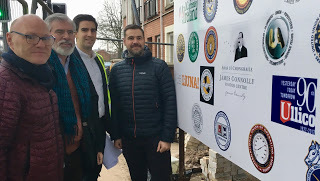 Writing about the Linen workers of Belfast Connolly wrote: ‘Many Belfast Mills are slaughterhouses for the women and penitentiaries for the children…Spinning is a skilled trade, requiring a long apprenticeship, alert brains, and nimble fingers. Yet for all this skill, for all those weary years of learning, for all this toil in a super-heated atmosphere, with clothes drenched with water, and hands torn and lacerated as a consequence of the speeding up of the machinery, a qualified spinner in Belfast receives a wage less than some of our pious millowners would spend weekly upon a dog.’Connolly was avowedly anti-sectarian. He understood how the unionist ascendancy employed sectarianism to divide workers and protect their interests. Writing in March 1911 he said:‘The Protestant workers of Belfast are essentially democratic in their instincts, but not a single Belfast Loyalist MP voted for the Old Age Pensions Act. The loyalist MPs knew that the beating of the orange drum would drown every protest within their constituencies.The development of democracy in Ireland has been smothered by the Union. Remove that barrier, throw the Irish people back upon their own resources, make them realize that the causes of poverty, of lack of progress, of arrested civic and national development, are then to be sought from within and not without, are in their power to remove or perpetuate, and ere long that spirit of democratic progress will invade and permeate all our social and civic institutions.’Three years later he spoke out against Partition. His words resonate today just as strongly as they did in 1914. Writing about the plan to partition Ireland Connolly warned that it would trigger a ‘carnival of reaction’. He wrote: ‘Such a scheme as that agreed to by Redmond and Devlin, the betrayal; of the national democracy of industrial Ulster would mean a carnival of reaction both North and South, would set back the wheels of progress, would destroy the oncoming unity of the Irish labour movement and paralyse all advanced movements whilst it endured. To it Labour should give the bitterest opposition, against it Labour in Ulster should fight even to the death, if necessary, as our fathers fought before us.’
Writing about the Linen workers of Belfast Connolly wrote: ‘Many Belfast Mills are slaughterhouses for the women and penitentiaries for the children…Spinning is a skilled trade, requiring a long apprenticeship, alert brains, and nimble fingers. Yet for all this skill, for all those weary years of learning, for all this toil in a super-heated atmosphere, with clothes drenched with water, and hands torn and lacerated as a consequence of the speeding up of the machinery, a qualified spinner in Belfast receives a wage less than some of our pious millowners would spend weekly upon a dog.’Connolly was avowedly anti-sectarian. He understood how the unionist ascendancy employed sectarianism to divide workers and protect their interests. Writing in March 1911 he said:‘The Protestant workers of Belfast are essentially democratic in their instincts, but not a single Belfast Loyalist MP voted for the Old Age Pensions Act. The loyalist MPs knew that the beating of the orange drum would drown every protest within their constituencies.The development of democracy in Ireland has been smothered by the Union. Remove that barrier, throw the Irish people back upon their own resources, make them realize that the causes of poverty, of lack of progress, of arrested civic and national development, are then to be sought from within and not without, are in their power to remove or perpetuate, and ere long that spirit of democratic progress will invade and permeate all our social and civic institutions.’Three years later he spoke out against Partition. His words resonate today just as strongly as they did in 1914. Writing about the plan to partition Ireland Connolly warned that it would trigger a ‘carnival of reaction’. He wrote: ‘Such a scheme as that agreed to by Redmond and Devlin, the betrayal; of the national democracy of industrial Ulster would mean a carnival of reaction both North and South, would set back the wheels of progress, would destroy the oncoming unity of the Irish labour movement and paralyse all advanced movements whilst it endured. To it Labour should give the bitterest opposition, against it Labour in Ulster should fight even to the death, if necessary, as our fathers fought before us.’
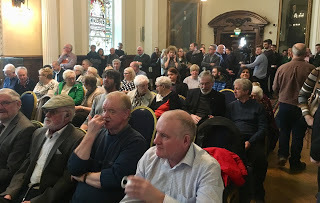 Connolly was a visionary. His declaration that ‘the cause of labour is the cause of Ireland and the cause of Ireland is the cause of labour’ is as true today as it was 100 years ago. Áras Uí Chonghaile is a hugely ambitious undertaking. I want to thank and commend all those who had the vision and energy to turn the dream into a reality. On April 19th – Good Friday – you are all invited to join in the pageant which will commence at 6pm at Conway Mill and walk along the Falls Road to Áras Uí Chonghaile. Be there to welcome James Connolly back to Belfast.
Connolly was a visionary. His declaration that ‘the cause of labour is the cause of Ireland and the cause of Ireland is the cause of labour’ is as true today as it was 100 years ago. Áras Uí Chonghaile is a hugely ambitious undertaking. I want to thank and commend all those who had the vision and energy to turn the dream into a reality. On April 19th – Good Friday – you are all invited to join in the pageant which will commence at 6pm at Conway Mill and walk along the Falls Road to Áras Uí Chonghaile. Be there to welcome James Connolly back to Belfast.
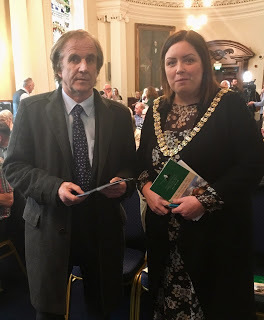
James Connolly Heron with Belfast Mayor Deirdre Hargey
Published on March 29, 2019 11:48
March 25, 2019
James Connolly Heron: Remarks to the City Hall Launch of Áras ÚI Chonghaile
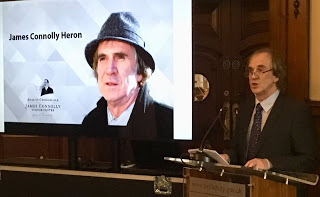
James Connolly Heron:Remarks to the City Hall Launch of Áras ÚI Chonghaile on Wednesday 20 March 2019:Chairperson, Thanks to the Committee for the invitation to this launch of a most important visitor centre in a city and in an area very close to the hearts of those of us fortunate to be related to a person still held in such high esteem at home and abroad. One hundred years on - Edinburgh, Belfast, New York, Chicago and Dublin - still hold the footprints of a remarkable journey for its time marking what was for James Connolly and his family, in his own words - ‘a full life’.It is a great honour to be here on what is a very special occasion - an historic day.Lord Mayor, Members of the Áras Uí Chonghaile Project, friends and comrades,‘REMEMBER ME IS ALL I ASK AND IF REMEMBRANCE PROVES A TASK – FORGET’. So wrote Nora Sullivan, republican prisoner in a Kilmainham Gaol prison autograph book.That golden generation - the men and women of 1916 - didn’t talk of themselves. They didn’t talk themselves up. Perhaps they felt no need. They had served the cause and we are the direct beneficiaries of their struggle, courage, their bravery and sacrifice. For those of us so privileged to have known them they didn’t appear to resent us that. They fought to free Ireland from oppression, slavery and conquest against all odds and we are forever in their debt. We didn’t tell them that, of course - perhaps WE felt there was no need. We trust now that they knew it. We have not seen their like since - we may never see their like again.My grandmother Ina Connolly became visibly upset whenever she spoke of her father. The effect of a brutal execution carried out at the dawn of a bright May morning passed on to a later generation. It was a struggle for her to write of that loss without breaking down. And so the questions that one might have asked were left unanswered for fear of causing upset. That is a regret now - the missed opportunities. The questions not asked yesterday sometimes come back to haunt us today. Such is life.Perhaps that is the case with every generation. But we should be mindful of it - in the words of the song - teach your children well. Driving my grandmother around Dublin and crossing the River Liffey to visit friends or family she would without fail pass comment on the skyscraper that is Liberty Hall - at the time our first and only skyscraper - the spiritual home of the trade union movement. A much maligned building at the time as the city’s first tower she held a counter view on its appearance and merits . ‘Oh If only Daddy could see Liberty Hall now’ she would say bursting with pride ‘ the Union with the tallest building in Dublin. He would not have believed it’. I never had the heart to tell her that there was great opposition to it at the time. For her it was a statement - a testament to her father’s life’s work - dedicated to the cause of labour and the cause of Ireland - his towering achievement reflected for her in a glowing edifice of shining light out of the darkness of a very different Ireland that she had known, lived, worked and grew up in. An Ireland of privilege over poverty, rich and poor, the haves over the have nots, the oppressor and the oppressed.And her father set out to change all that.He burned to end it as a self-proclaimed ‘disturber of the political peace’.True revolutionaries dedicate themselves twice, he wrote, first in the flush of youth, then in the wisdom of maturity’.And his family never wavered in supporting him every step of the way - from bright beginning to sad dark end. When I first learnt of this Aras project on the occasion of the unveiling of the JC monument on the Falls Road I stood on a street corner and listened as the grand plan was explained. I admit to have being a little sceptical as to it ever coming to pass. It was to my mind an incredible undertaking and in ways a dream that was unlikely to be realised. How wrong I was - I am pleased to say. The continuing 17 year long campaign to Save Moore Street from the developers wrecking ball has obviously left its mark on me. Our aim is to develop a 1916 Historic Cultural Quarter there - on the very ground that our forebears made history. But today the last HQ of the 1916 Provisional Government still lies neglected and abandoned by successive administrations and is closed to the public. Restoration work undertaken under pressure, plans for its future still uncertain. Described by the National Museum as’ the most important historic site in modern Irish history’ the area is is now under the ownership and control of a British based vulture capital fund - the irony of that apparently lost on those holding office. Today I take this opportunity to salute Sinn Fein for their unstinting support for the Moore Street Campaign. In particular, the late and much missed Martin Mc Guinness, Gerry Adams,TD, and Uachtarain Shinn Fein, Mary Lou Mc Donald. Councillors Criona Ni Dalaigh and Cllr. Michael Mac Donncha also did sterling work on our behalf when holding office as successive Lord Mayor’s of Dublin. This project, from dream to reality, puts the authorities in Dublin to shame. The success of one development stands in marked contrast to the inexplicable paralysis surrounding another.When Joe and Harry outlined progress on the plan on a recent visit to Dublin and fittingly in the GPO, it was clear that this day would indeed come to pass. Their sterling work rewarded. A dream realised. The story of a success. Of course the reason this has been achieved is directly associated with the area in which it is located. Where people appreciate and connect to their proud past, guard the memory of their heroes, preserve the record and stand up to be counted. A community bound together through great struggle is a stronger community in the long run - hurdles are to be leapt over - failure is not an option - dreams can never die. Everyone can play a part. And in this case where there is a will there is a way. This visitor centre celebrating the life and times of James Connolly will not only benefit tourism, education and community relations - it will change lives. Cultural centres can become the heartbeat of a community. Where lessons are learned relationships built, friendships flourish and lives are enriched. Communities are under threat in an ever changing world. What were traditional hubs in the community where, news and views were exchanged and shared - the local shop or store, the post office or community hall or local pub are fast becoming a thing of the past - our lives are becoming more privatised - leaving many citizens isolated some abandoned, some lost, others lonely. A community without conversation is a community in crisis. There is no such thing as society if we do not strive to keep it intact. Social interaction respect and understanding among all citizens are its vital ingredients. The heroes of our time will emerge from the struggles of today and not out of the comforts of tomorrow. The value and values of times past held in trust within the community and passed to future generations will be the story of this success. In many ways this new centre brings James Connolly and his family home. Here in the city that marked him and his children and one that Lillie Connolly in particular did not want to leave. She left Belfast with tears in her eyes as the family made their way to Dublin for the final chapter in what was and is a remarkable family story.This city helped shape her husband as a trade union leader and defender of workers’ rights. Their fight was his fight, their struggle his struggle, their cause his cause - to the very end. Here he stood for election as the’ determined enemy of the domination of class over class, of nation over nation, of sex over sex, who will at all times stand for the cause of the lowly-paid and oppressed’. My grandmother and grand Aunt Nora joined the Fianna here and Ina became secretary of the Betsy Gray Cumann with, as she puts it, ‘their headquarters in old wooden army huts on the Falls Road built to house soldiers who kept the peace as it was called when there was rioting in Belfast’. The baton in their family had already passed to the next generation.And It was in Belfast that they first enjoyed the stability and comfort of their first real family home. The joining of forces behind this project is also a great testament to their father’s refusal in his time to engage in sectarianism of any kind. To build a society based on opportunity for all, with equality in housing, health, and education - basic civil rights - rights that had to be fought for in our time - at home and abroad and still not realised. The pillars of a real democracy where nobody is left behind, marginalised, abandoned or forgotten. My grandmother in her biography of her father wrote: “Accused of being fanatically Nationalist on one hand and not Nationalistic on the other James Connolly found one home, one country - the hearts of the working people of the world. Sacrifice and devotion to their cause was the weather of his mind and the keystone of his work”.How fitting therefore that this project has had widespread support from near and far.Writing in The Irish Worker during municipal elections in 1913 he himself wrote: “A small nation such as Ireland can only become great by reason of the greatness of soul of its individual citizens. Discontent is the fulcrum upon which the lever of thought has ever moved the world to action. Ireland has two things that must make the blood run with exaltation in the veins of every lover of the Irish race - a discontented working class and the nucleus of a rebellious womanhood. I cannot separate these two things in my mind”.Winifred Carney, Margaret Skinnider, Countess Markievicz among the great rebel women of his time. The heroes of our history.The lesson of this success is that working together Citizens are best placed to build a future shaped by all and not designed by the few, planned for all and not to benefit the few. That ‘greatness of soul’ of the individual citizen allowed flourish so that all have the opportunity to make a contribution to society for the betterment of all. A peoples project - evidence yet again that there is so much more to unite us than there is to divide us.And West Belfast again showing the way forward. Great credit and enormous thanks is due to all who have given their time energy and talent to see it through. To Joe, Harry, Jim and the committee and all who helped in any way this is your day. Your work now takes tangible physical form and this visitor centre will no doubt influence, educate and inspire a new generation to strive to achieve equality and justice for all. And though this is your deserved day in the sun - you allow us bask in its reflective light.By honouring the memory of my great grandfather his life and times in this way you also pay family members great tribute - undeserved but accepted with humility and gratitude.I can only imagine what my grandmother would think of the development of this centre honouring the name, memory and sacrifice of her father within a stones throw of the family home.I know that were she here today she would be bursting with pride. As I am. We salute you. We are forever in your debt. James Connolly Heron
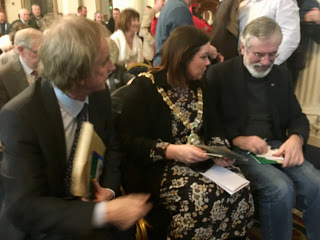
Published on March 25, 2019 03:43
March 21, 2019
No Planet B???? - 12 years to save the planet
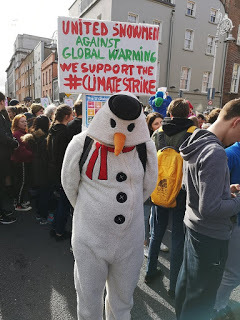 Protesting outside Leinster HouseLast week tens of thousands of school pupils in Ireland, and in over 100 countries across the world, took part in an unprecedented demonstration highlighting the threat to humanity from climate change. Thousands took part in an impressive protest outside the Dáil. They were all united in their demand that governments must do more to save the planet. The extraordinary enthusiasm, commitment and determination of the young people, was inspirational. Friday’s protests are the latest in the ‘school strike movement’ that has been inspired by the actions of Greta Thunberg, a 16 year old Swedish teenager. Thunberg has sat outside the Swedish Parliament almost every Friday since last summer demanding that her government implement the Paris agreement on climate change.
Protesting outside Leinster HouseLast week tens of thousands of school pupils in Ireland, and in over 100 countries across the world, took part in an unprecedented demonstration highlighting the threat to humanity from climate change. Thousands took part in an impressive protest outside the Dáil. They were all united in their demand that governments must do more to save the planet. The extraordinary enthusiasm, commitment and determination of the young people, was inspirational. Friday’s protests are the latest in the ‘school strike movement’ that has been inspired by the actions of Greta Thunberg, a 16 year old Swedish teenager. Thunberg has sat outside the Swedish Parliament almost every Friday since last summer demanding that her government implement the Paris agreement on climate change.
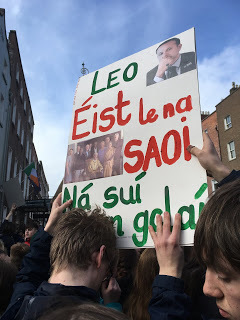 Just before Christmas she spoke at the COP24 climate talks that took place in Katowice, Poland. Her scathing criticism of the international community and of governments struck a chord with many young people – and older citizens. Thunberg told political leaders: “You only speak of green eternal economic growth because you are too scared of being unpopular. You only talk about moving forward with the same bad ideas that got us into this mess, even when the only sensible thing to do is pull the emergency brake. You are not mature enough to tell it like is. Even that burden you leave to us children. But I don’t care about being popular. I care about climate justice and the living planet. Our civilization is being sacrificed for the opportunity of a very small number of people to continue making enormous amounts of money. Our biosphere is being sacrificed so that rich people in countries like mine can live in luxury. It is the sufferings of the many which pay for the luxuries of the few.”She told political leaders: “You say you love your children above all else, and yet you are stealing their future in front of their very eyes”.Four years ago 197 countries came together in Paris to map out an agreement to hold the rise in global average temperatures to “well below 2 degrees Celsius above pre-industrial levels” and to make a significant effort to keep it to 1.5 degrees Celsius.
Just before Christmas she spoke at the COP24 climate talks that took place in Katowice, Poland. Her scathing criticism of the international community and of governments struck a chord with many young people – and older citizens. Thunberg told political leaders: “You only speak of green eternal economic growth because you are too scared of being unpopular. You only talk about moving forward with the same bad ideas that got us into this mess, even when the only sensible thing to do is pull the emergency brake. You are not mature enough to tell it like is. Even that burden you leave to us children. But I don’t care about being popular. I care about climate justice and the living planet. Our civilization is being sacrificed for the opportunity of a very small number of people to continue making enormous amounts of money. Our biosphere is being sacrificed so that rich people in countries like mine can live in luxury. It is the sufferings of the many which pay for the luxuries of the few.”She told political leaders: “You say you love your children above all else, and yet you are stealing their future in front of their very eyes”.Four years ago 197 countries came together in Paris to map out an agreement to hold the rise in global average temperatures to “well below 2 degrees Celsius above pre-industrial levels” and to make a significant effort to keep it to 1.5 degrees Celsius.
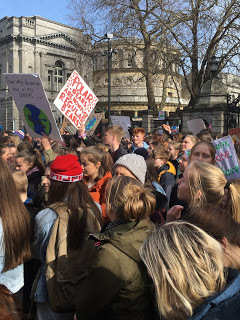 Last October the UN Intergovernmental Panel on Climate Change (IPCC) published a shocking report which underlined the catastrophic risks posed to humanity by climate change. The authors of the report – the world’s leading climate scientists – warned that we have only 12 years to limit climate change before the people of the world face extreme droughts, heat, floods, increased food insecurity and water supply, and increased poverty for hundreds of millions of citizens.The world is already one degree warmer than preindustrial levels. This might not seem a lot but the effect was very obvious last year with unprecedented heat waves, hurricanes and typhoons. Destructive human exploitation of our natural resources; damage being done by climate change; and the effect on world animal and insect populations since 1970, are all having a significant impact. According to the 2018 Living Planet Index published by the World Wildlife Fund Central and South America have suffered an 89 per cent loss in species populations since 1970. On the island of Ireland the National Biodiversity Data Centre reports that one third of our bee species – which are essential for pollination – is either regionally extinct or vulnerable. The current evidence suggests that without serious remedial action by governments we could see global temperatures increase to between 3 and 5 degrees Celsius. Even at 2 degrees Celsius the disappearance of Artic Sea ice threatens the jet stream which determines our weather systems. The IPCC report concludes that a 2 per cent Celsius increase in global warming will lead to more heat related deaths, smaller crop yields, more extreme weather events, and slower economic growth. Just before Christmas delegates from states around the world gathered in Katowice in Poland for a two week conference to revive the Paris 2015 deal. The UN Secretary General Antonio Guterres issued a stark warning when he said that the world “is way off course” to prevent catastrophic climate change. When the conference was over some progress had been achieved on agreeing how governments will measure and report on their efforts to cut carbon emissions. However, the USA, Russia, Kuwait and Saudi Arabia blocked the conference from accepting in full the IPCC findings on climate change. As if to underline the threat a review of the research of the Intergovernmental Panel on Climate Change (IPCC) published in January in the prestigious journal Science concludes that previous estimates on the warming of the Oceans has been too low. The report states that: “multiple lines of evidence from four independent groups thus now suggest a stronger observed [ocean heat content] warming.”The Oceans are heating up 40 per cent faster than previously believed. The impact of this will be far reaching. The bleaching of coral will worsen – affecting fish stocks – and some species of fish will be forced to migrate to cooler waters.One example of this is the fate of squid in northern Japan. A report in October last year revealed that the population of Japanese flying squid, which has been a key part of the Japanese diet, has been significantly depleted. In 2011 Japanese fishermen caught two hundred thousand tons. Last year that figure was down to 53,000 tons. While over fishing has played its part, so too has the increase in sea temperatures. The Sea of Japan has warmed by 1.7 degrees Celsius and is expected to rise by almost 4 degrees Celsius by the end of this century. Marine life is looking for cooler waters.
Last October the UN Intergovernmental Panel on Climate Change (IPCC) published a shocking report which underlined the catastrophic risks posed to humanity by climate change. The authors of the report – the world’s leading climate scientists – warned that we have only 12 years to limit climate change before the people of the world face extreme droughts, heat, floods, increased food insecurity and water supply, and increased poverty for hundreds of millions of citizens.The world is already one degree warmer than preindustrial levels. This might not seem a lot but the effect was very obvious last year with unprecedented heat waves, hurricanes and typhoons. Destructive human exploitation of our natural resources; damage being done by climate change; and the effect on world animal and insect populations since 1970, are all having a significant impact. According to the 2018 Living Planet Index published by the World Wildlife Fund Central and South America have suffered an 89 per cent loss in species populations since 1970. On the island of Ireland the National Biodiversity Data Centre reports that one third of our bee species – which are essential for pollination – is either regionally extinct or vulnerable. The current evidence suggests that without serious remedial action by governments we could see global temperatures increase to between 3 and 5 degrees Celsius. Even at 2 degrees Celsius the disappearance of Artic Sea ice threatens the jet stream which determines our weather systems. The IPCC report concludes that a 2 per cent Celsius increase in global warming will lead to more heat related deaths, smaller crop yields, more extreme weather events, and slower economic growth. Just before Christmas delegates from states around the world gathered in Katowice in Poland for a two week conference to revive the Paris 2015 deal. The UN Secretary General Antonio Guterres issued a stark warning when he said that the world “is way off course” to prevent catastrophic climate change. When the conference was over some progress had been achieved on agreeing how governments will measure and report on their efforts to cut carbon emissions. However, the USA, Russia, Kuwait and Saudi Arabia blocked the conference from accepting in full the IPCC findings on climate change. As if to underline the threat a review of the research of the Intergovernmental Panel on Climate Change (IPCC) published in January in the prestigious journal Science concludes that previous estimates on the warming of the Oceans has been too low. The report states that: “multiple lines of evidence from four independent groups thus now suggest a stronger observed [ocean heat content] warming.”The Oceans are heating up 40 per cent faster than previously believed. The impact of this will be far reaching. The bleaching of coral will worsen – affecting fish stocks – and some species of fish will be forced to migrate to cooler waters.One example of this is the fate of squid in northern Japan. A report in October last year revealed that the population of Japanese flying squid, which has been a key part of the Japanese diet, has been significantly depleted. In 2011 Japanese fishermen caught two hundred thousand tons. Last year that figure was down to 53,000 tons. While over fishing has played its part, so too has the increase in sea temperatures. The Sea of Japan has warmed by 1.7 degrees Celsius and is expected to rise by almost 4 degrees Celsius by the end of this century. Marine life is looking for cooler waters.
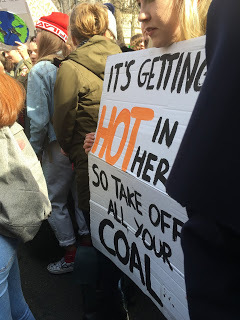 The evidence is overwhelming. Humanity faces greater challenges than ever before. Without resolute action millions are at risk. In May in the local government elections North and South, and in the European election in the South Climate Change will be a priority for Sinn Féin. But effecting real change and forcing reluctant governments and climate change deniers to implement real and effective policy changes will require a mass campaign. Last week young people showed the way. Their example must guide us in the time ahead.
The evidence is overwhelming. Humanity faces greater challenges than ever before. Without resolute action millions are at risk. In May in the local government elections North and South, and in the European election in the South Climate Change will be a priority for Sinn Féin. But effecting real change and forcing reluctant governments and climate change deniers to implement real and effective policy changes will require a mass campaign. Last week young people showed the way. Their example must guide us in the time ahead.
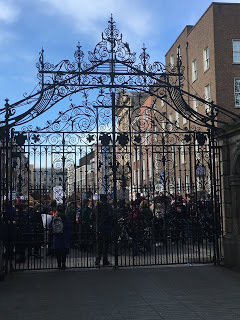
Published on March 21, 2019 06:50
March 18, 2019
Raidió Fálte takes up a new home
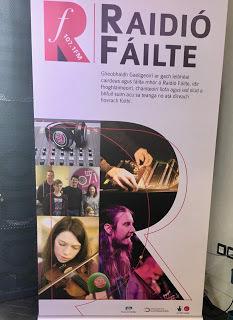
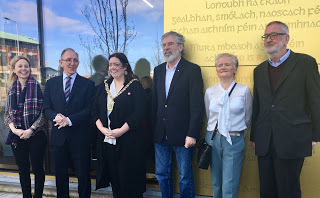 D’oscail suíomh nua Raidió Fáilte ar an Aoine seo caite. Seo m’cuid foclaí ón imeacht.
D’oscail suíomh nua Raidió Fáilte ar an Aoine seo caite. Seo m’cuid foclaí ón imeacht. "Molaim achan duine a chuidigh le Líonra Uladh – Raidió Fáilte a bhunú.
Ach tá moladh ag dul do Fergus Í hÍr go hairithe.
Ghlac Fergus páirt i nGluaiseacht na gCeart Sibhialta. Is fear gnímh é.
D’inis sé scéal dúinn le déanaí faoi na hAontachtóirí sna seascaidí nuair a chuir siad bac ar pháirc na leanaí mar Dé Domhnaigh a bhí ann.
Is ceannródaí Gaeilge é Fergus, iar Phríomh Oide i Meánscoil Feirste, amhránai den scoth, craoltóir, bullaí fir agus scoláire.
Nuair a bhunaigh Eoin O’Néill, Fergus, Gearóid O Cearbhalláin agus Clara Ní Giolla Raidio Failte i lár na nóchaidí bhí sé ar an aer go minic agus ansin bhí sé mar bhainisteoir.
Mar a deir siad féin sin na laethanta nach raibh siad ag cloí leis an dlí!!!
These were their ‘pre-legal days.
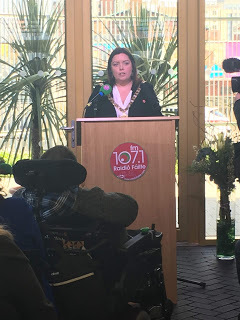 Fuair siad an ceadíúnas in dá mhíle is a sé agus chuiagh siad ó neart go neart.
Fuair siad an ceadíúnas in dá mhíle is a sé agus chuiagh siad ó neart go neart.Le fiche bliain tá seirbhís iontach luachmhar curtha ar fáil ag Raidió Fáilte.
Tá an foirgnmeamh seo mar léargas ar an díogras a chuir siad isteach.
Áis iontach atá ann.
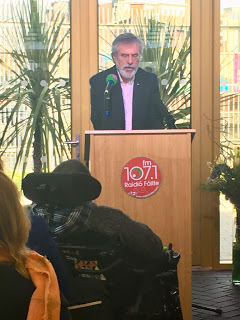 Tá sé i gcroílár Iarthar Bhéal Feirste agus An Cheathrú Gaeltachta.
Tá sé i gcroílár Iarthar Bhéal Feirste agus An Cheathrú Gaeltachta.Infheistíocht thábhachtach é i bhforbairt chraoltóireacht na Gaeilge sa tuaisceart sna blianta amach romhainn.
Beidh áiseanna craoltóireachta, cartlannaíochta agus oiliúna den chéad scoth anseo.
Molaim an ailtire Ciarán Mackle agus McGurks as an fhís a bhí acu chun an spás seo a úsáid.
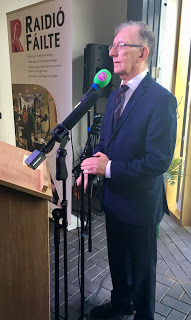 Molaim Roinn na bPobal agus Comhairle Cathrach Bhéal Feirste a bhfuil thart faoi million go leith punt curtha acu leis an togra seo.
Molaim Roinn na bPobal agus Comhairle Cathrach Bhéal Feirste a bhfuil thart faoi million go leith punt curtha acu leis an togra seo.Mo bhuíochas go speisialta le Ciste Infheistíochta Gaeilge a bhfuil trí chéad mile punt curtha acu leis an togra seo.
Ó bunaíodh é ocht mblianta ó shin tá breis is sé mhilliún punt curtha acu le tríocha trí togra.
Mar gheall ar seo agus trí bheith ag obair le forbairthoirí tograí tá trí mhilliún déag breise curtha ar fáil ar son áiseanna do phobal na Gaeilge.
Tá fiche ‘s a haon togra faoi lan seoil agus tá cúig cinn eile ag teacht.
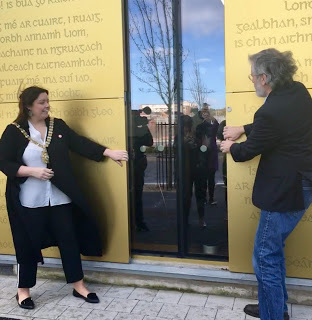 Tháinig Ciste ar an saol mar gheall ar na comhchainteanna a rinne i Hillsborough in da mhíle is a deich.
Tháinig Ciste ar an saol mar gheall ar na comhchainteanna a rinne i Hillsborough in da mhíle is a deich.Ag an tráth sin d’éirigh le Sinn Féin gealltanas a fháil go mbeadh fiche milliún punt le caitheamh ar thograí Gaeilge.
Ag an am sin dúirt mé gur beagán a bhí ann mar go raibh pobal na Gaeilge i dteideal i bhfad i bhfad níos mo airgis.
Ach tús a bhí ann.
Mar is eol dom féin, tús maith, leath na hoibre.
Agus leis an méid airgis sin d’éirigh le pobal na Gaeilge
Bhí dhá mhilliún déag le caitheamh ar Chiste Craoltóireachta na Gaeilge agus ocht milliún le haghaidh tograí caipitil.
Bunaíodh Ciste Infheistíochta Gaeilge chun an ciste seo a riaradh agus d’éirigh go han-mhaith leo an chuid is fearr a bhaint as méid airgid atá beag go leor, dar leat.
Tá an Ciste ann chun pobail Gaeilge a chothú agus cuidiú leo; chun tacú airgidis a chur ar fáil do thograí caipitil chun postanna a chruthú agus chun ceathrúnaí cultúrtha a bhunú.
Feicim go bhfuil cara liom anseo inniu, iar-Aire Caral Ni Chuilín.
Ghlac Caral agus Airí eile ar nos Michelle Gildernew, Caitriona Ruane, Bairbre de Brún agus John O’Dowd ról lárnach
Tá na mílte ógánach a fuair a gcuid oideachais trí mheán na Gaeilge nó atá sa chóras faoi láthair.
Is leo féin an todhchaí agus ta dualgas orainn a chinntiú go mbeidh deiseanna fostaíochta agus áiseanna pobail ann le go mbeidh tacaíocht pobail, fostaíocht agus áiseanna oiliúna ar fáil dóibh.
Tá dualgas eile orainn fosta cinntiú go bhfuil aitheantas ann don Ghaeilge agus cosaint reachtúil aici agus go nglacfar leis an cheart do shaol a chaitheamh trí mheán na Gaeilge.
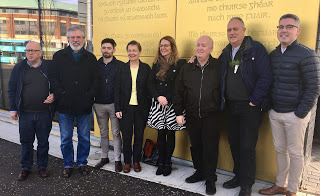 Tá bród mor orm gur féidir liom mo chuid chúnamh a dhéanamh anseo in Iarthar Bhéal Feirste go hiomlan trí mheán na Gaeilge bíodh sin nuachtan a cheannach, bearradh gruaige agus féasóige a fháil, cupán caifé a fháil nó pionta a chaitheamh siar.
Tá bród mor orm gur féidir liom mo chuid chúnamh a dhéanamh anseo in Iarthar Bhéal Feirste go hiomlan trí mheán na Gaeilge bíodh sin nuachtan a cheannach, bearradh gruaige agus féasóige a fháil, cupán caifé a fháil nó pionta a chaitheamh siar.Agus is feidir liom éisteacht le Raidió Fáilte fosta.
As sin amháin tá me fíor bhuíoch do achan duine anseo inniu. Maith sibh.
Lá Féile Padraig faoi mhaise daoibhse.
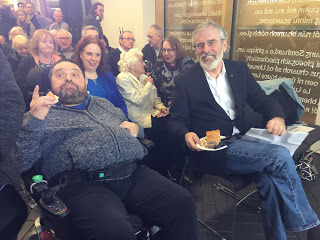
Published on March 18, 2019 04:26
March 14, 2019
Britain waives the rules. Arís
As this column goes to print the British Prime Minister has lost two key votes this week in the British Parliament on the Brexit issue. It is pointless speculating at this time on the outcome of these machinations. But there is one certainty. Irish interests will have little influence. When Britain leaves the EU – the North of Ireland will be dragged with them, and no matter about assurances, real or illusory, that is bad for Ireland. So what’s new? British rule has always been bad for Ireland. Take Karen Bradley for example.
Whatever the future holds for Karen Bradley, the British Secretary of State said last week what she and her government really believe. She set out in two short sentences the premise on which the British government’s legacy strategy is built. Bradley said: “The fewer than ten per cent (of deaths) that was at the hands of the military and police were not crimes. They were people acting under orders and under instruction and fulfilling their duty in a dignified and appropriate way.”
The outrage from victims’ families and support groups, Sinn Féin, the SDLP, the Alliance Party, the Irish government and a range of media and political commentators, including some in Britain, forced Bradley to apologise. But the fact is that Bradley was expressing British government policy. This policy is about defending members of the British Army, RUC, UDR and the range of British intelligence agencies, and politicians who ran Britain’s dirty war in the North.
A recent example of this policy was the arrest last August of Trevor Birney and Barry McCaffrey, two investigative journalists, who were part of the team that produced ‘No Stone Unturned.’ This is a documentary film about RUC collusion and the Loughinisland murders in 1994. They were arrested over the alleged theft from the Police Ombudsman’s office of a confidential document relating to the murder of the six men in the County Down village. The Ombudsman’s office says it never made a complaint of a theft.
This attempt to gag two reporters follows a long tradition of media control and manipulation by British governments and their security agencies. The broadcasting restrictions of the Thatcher years, when my voice and that of other Sinn Féin representatives were banned from the broadcast media, are probably the best known. But censorship existed almost from the time the first British soldier stepped foot on the streets of the North in 1969. In the years that followed, the RUC, British Army and Northern Ireland Office became expert at black propaganda, spinning lines and at covering up the criminal actions of the RUC, British Army, and of their agents operating within the unionist death squads.
There are countless examples of this including media coverage of the Falls Curfew, the introduction of internment, the Ballymurphy Massacre, the McGurk’s Pub bombing, Bloody Sunday, the New Lodge killings, the Springhill murders and many more. British Army and RUC briefings, usually used verbatim by many newspapers and broadcasters, often described innocent victims as ‘gunmen’ ‘gun women’ ‘known terrorists’and ‘bombers.’
This strategy of manipulating elements of the media is a long established part of Britain’s counter-insurgency strategies. It was especially effective in creating distractions, confusion and misunderstanding around British actions, including the deliberate killing of citizens by the British state using agents and informers.
But psyops – psychological warfare - black propaganda - also has an important secondary role. In the battle for ‘hearts and minds’ a key objective is to present the British forces as always operating within the law. This allowed Tory and Labour governments, especially internationally, to pose as ‘working within the law’ and ‘obeying the rule of law’. The fact that they changed the law to suit their needs is often lost.
In this way Britain could claim a dubious and false moral superiority in fighting its war in the North. It also succeeded in frustrating the demands for truth. This strategy is evident in the long delays faced by the Bloody Sunday families, or the families of the Ballymurphy Massacre, or the Springhill families or the McGurk pub bomb families. Almost half a century has passed since these murders occurred.
Delay, delay, delay, has been fundamental to Britain’s strategic approach. Why? Because the direct responsibility for much of British policy, including state collusion, shoot-to-kill and other policies goes right to the top of the British political system. The British government wants to protect former political leaders, the generals and the spooks who authorised state murder.
This is the real context of Karen Bradley’s remarks. Last November she told the ‘Northern Ireland Affairs Committee in Westminster’ that, “I think we have got to find a way of getting our soldiers off this hook. I think it's up to political people like ourselves to sort it and change the law if necessary”.
Finally, it should be remembered that the British Army and its counter-insurgency strategy is still at work in other places. According to General Sir Mike Jackson, who was second in command of the Parachute Battalion which killed 14 people on Bloody Sunday, writing in the foreword to‘Operation Banner – An Analysis of Military Operations in Northern Ireland 1969-2006’: “The immediate tactical lessons of Operation BANNER have already been exported elsewhere, with considerable success. Operations in the Balkans, Sierra Leone, East Timor, Afghanistan and Iraq have already demonstrated both the particular techniques and the levels of expertise learnt through hard experience, both on the streets and in the fields of Northern Ireland”.
The reality of Jackson’s boast is much different. The myth of British superiority in fighting counter-insurgency wars is just that – a myth. It failed to protect the British Empire. Those who fought for and demanded freedom and independence from Britain didn’t give up. As a consequence, in the 30 years after World War Two, Britain was forced to leave over 20 countries. So Brit Secretaries of State like Ms Bradley’s will come and go. So will Brexit. So we need a long view of history. And the future. That is the real lesson for those seeking Irish freedom and independence – never give up.
Whatever the future holds for Karen Bradley, the British Secretary of State said last week what she and her government really believe. She set out in two short sentences the premise on which the British government’s legacy strategy is built. Bradley said: “The fewer than ten per cent (of deaths) that was at the hands of the military and police were not crimes. They were people acting under orders and under instruction and fulfilling their duty in a dignified and appropriate way.”
The outrage from victims’ families and support groups, Sinn Féin, the SDLP, the Alliance Party, the Irish government and a range of media and political commentators, including some in Britain, forced Bradley to apologise. But the fact is that Bradley was expressing British government policy. This policy is about defending members of the British Army, RUC, UDR and the range of British intelligence agencies, and politicians who ran Britain’s dirty war in the North.
A recent example of this policy was the arrest last August of Trevor Birney and Barry McCaffrey, two investigative journalists, who were part of the team that produced ‘No Stone Unturned.’ This is a documentary film about RUC collusion and the Loughinisland murders in 1994. They were arrested over the alleged theft from the Police Ombudsman’s office of a confidential document relating to the murder of the six men in the County Down village. The Ombudsman’s office says it never made a complaint of a theft.
This attempt to gag two reporters follows a long tradition of media control and manipulation by British governments and their security agencies. The broadcasting restrictions of the Thatcher years, when my voice and that of other Sinn Féin representatives were banned from the broadcast media, are probably the best known. But censorship existed almost from the time the first British soldier stepped foot on the streets of the North in 1969. In the years that followed, the RUC, British Army and Northern Ireland Office became expert at black propaganda, spinning lines and at covering up the criminal actions of the RUC, British Army, and of their agents operating within the unionist death squads.
There are countless examples of this including media coverage of the Falls Curfew, the introduction of internment, the Ballymurphy Massacre, the McGurk’s Pub bombing, Bloody Sunday, the New Lodge killings, the Springhill murders and many more. British Army and RUC briefings, usually used verbatim by many newspapers and broadcasters, often described innocent victims as ‘gunmen’ ‘gun women’ ‘known terrorists’and ‘bombers.’
This strategy of manipulating elements of the media is a long established part of Britain’s counter-insurgency strategies. It was especially effective in creating distractions, confusion and misunderstanding around British actions, including the deliberate killing of citizens by the British state using agents and informers.
But psyops – psychological warfare - black propaganda - also has an important secondary role. In the battle for ‘hearts and minds’ a key objective is to present the British forces as always operating within the law. This allowed Tory and Labour governments, especially internationally, to pose as ‘working within the law’ and ‘obeying the rule of law’. The fact that they changed the law to suit their needs is often lost.
In this way Britain could claim a dubious and false moral superiority in fighting its war in the North. It also succeeded in frustrating the demands for truth. This strategy is evident in the long delays faced by the Bloody Sunday families, or the families of the Ballymurphy Massacre, or the Springhill families or the McGurk pub bomb families. Almost half a century has passed since these murders occurred.
Delay, delay, delay, has been fundamental to Britain’s strategic approach. Why? Because the direct responsibility for much of British policy, including state collusion, shoot-to-kill and other policies goes right to the top of the British political system. The British government wants to protect former political leaders, the generals and the spooks who authorised state murder.
This is the real context of Karen Bradley’s remarks. Last November she told the ‘Northern Ireland Affairs Committee in Westminster’ that, “I think we have got to find a way of getting our soldiers off this hook. I think it's up to political people like ourselves to sort it and change the law if necessary”.
Finally, it should be remembered that the British Army and its counter-insurgency strategy is still at work in other places. According to General Sir Mike Jackson, who was second in command of the Parachute Battalion which killed 14 people on Bloody Sunday, writing in the foreword to‘Operation Banner – An Analysis of Military Operations in Northern Ireland 1969-2006’: “The immediate tactical lessons of Operation BANNER have already been exported elsewhere, with considerable success. Operations in the Balkans, Sierra Leone, East Timor, Afghanistan and Iraq have already demonstrated both the particular techniques and the levels of expertise learnt through hard experience, both on the streets and in the fields of Northern Ireland”.
The reality of Jackson’s boast is much different. The myth of British superiority in fighting counter-insurgency wars is just that – a myth. It failed to protect the British Empire. Those who fought for and demanded freedom and independence from Britain didn’t give up. As a consequence, in the 30 years after World War Two, Britain was forced to leave over 20 countries. So Brit Secretaries of State like Ms Bradley’s will come and go. So will Brexit. So we need a long view of history. And the future. That is the real lesson for those seeking Irish freedom and independence – never give up.
Published on March 14, 2019 05:39
March 8, 2019
Eamonn McCaughley: a courageous, thoughtful republican and comrade
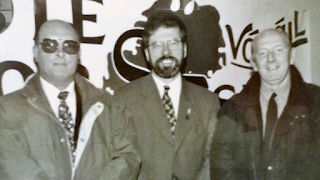 Big Eamonn, Mise agus Cleaky Clarke
Big Eamonn, Mise agus Cleaky Clarke
These are my remarks at the funeral of Eamonn McCaughley - Big Eamonn - in Twinbrook on Wednesday:
This is our families second funeral in the last few days.
Last Friday we buried my brother Liam.
Go ndéana Dia trócaire air. Tá Claire agus Bronagh anseo inniu. Tá fáilte romhaibh.
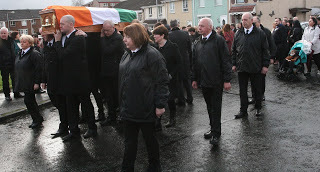 On his way to the funeral Eamonn died suddenly from a heart attack.
On his way to the funeral Eamonn died suddenly from a heart attack. I want to thank everyone who has supported us or who sent messages of support during this difficult time.
Tá muid buioch daoibhse go leir.
This is also my sister Margaret’s birthday so lá breithe shona duit Maggie. I gave PaddyA a few quid to get you a drink later on.
Tá muid anseo inniu chun ceiliúradh a dhéanamh ar saol Eamonn ceann de na fir láidir Eamonn Mór, fear, athair, seánathar, deartháir; ár gcomrádaí, ár gcara, ár dheathár, ár gceannaire.
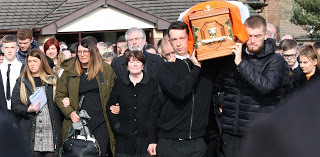 Eamonn would be scundered at all the fuss we have been making of him.
Eamonn would be scundered at all the fuss we have been making of him. He would be scundered but he would also be chuffed. That was his way. He was a modest shy man.
He first came into my life when he started chasing my sister Anne away back in the days when we went to ceilis in An Ard Scoil and later in the 43 Club.
Eamon was a mod. With an Elvis Presley hair style.
He was born into a staunchly republican family sixteen years earlier.
His mother Nelly and father Dan were republican activists in their own time.
Nelly was from Bombay Street.
She was a volunteer in Cumann na mBan and later its OC in Belfast
Eamonn’s father Dan was originally from Lurgan before moving to Ballymacarrett in East Belfast.
He was interned in the 1940s and again in the fifties.
Eamonn was born in Ballymacarrett in 1949.
The family moved in the 1950s to Kenard Avenue in Andytown.
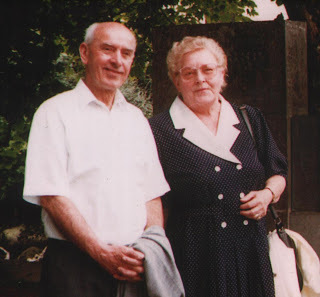
Dan and Nellie McCaughley
In the mid 1960’s republicans were reorganizing.
Across the world progressive people were on the rise.
In South Africa, Cuba, across Europe and in the USA.
The demand was for rights and for freedom.
So too here in Ireland, particularly in the North where – surprise, surprise there was resistance to the modest demands of the civil rights struggle.
There was also time for fun.
Bhí craic ann. Ag ceol. Uaireannta maith.
For scorieachts. Singing sessions. Bus trips to Tyrella. Excursions to Edentubber and Bodenstown.
And all time Eamonn was courting Anne.
By now he was a regular feature in our house where he often entertained us with Elvis songs or a Roy Orbison number and his own peculiar form of jiving.
Eamonn first joined Na Fianna and then the Army.
During the pogroms of August 1969 Eamonn was in the front line helping to evacuate his Granny and others from Bombay Street, and then from other districts under attack from RUC, B Special and loyalist mobs.
In the immediate aftermath of the pogroms there was a split in the Army in December 1969 and in Sinn Féin in 1970.
And in the long lens of history this represented a significant set-back for the struggle.
For a short time Eamonn stayed with the Official IRA but he quickly shifted his support to the Provisional Army Council.
He and Anne were married on 5 April 1971.
Bhí ceathar paistí acu: Eamon agus Fionnuala, Seán agus Bronagh.
During the 1970’s Eamonn was arrested and interned twice.
His sister Briege Anne was in Armagh Women’s Prison.
Today, is for all of us who had the joy and honour to know Big Eamonn a day to remember with affection and pride a man of enormous courage.
He was a quiet thoughtful republican.
He never said a sectarian word in my presence in his life who rarely talked about his time as an Oglach.
A faithful loyal comrade who dedicated years of his life to the cause of Irish freedom and to the Irish people.
Fear croaga Eamonn – Mo Laoch. Mo Giolle mhear.
Big Eamonn loved Ireland – he loved the people of Ireland.
It was in his DNA.
He was also a loving and attentive son and brother, a devoted husband, father and grandfather.
So, on my own behalf and that of Colette.
Colette always sent Eamonn a bottle of Bacardi every Christmas and he always received it as if it was the only bottle of Bacardi in the entire world and as if he was surprised by it.
So on my own family, and on behalf of Republicans everywhere, I want to extend our heartfelt condolences to Anne, Eamonn, Fionnuala, Sean and Bronagh, to Patricia, to Gemma, and to Charlie and to the grandchildren and great grand-daughter.
Condolences also to Maire, Fionnuala, Briege Anne, and Ciaran and remembering also Big Eamonn’s brother Donal who died four years ago to the day that Eamonn passed.
You are all in our prayers and our thoughts.
My chomhbhrón also, to Eamonn’s comrades and to the former prisoners who did time with him.
He would be very proud and pleased with the geriatric Guard of Honour. All the aul timers.
My commiserations and thanks also to Eamonn’s workmates in Healy’s Undertakers and to the paramedics and doctors and nurses who minded him when he took sick last Friday.
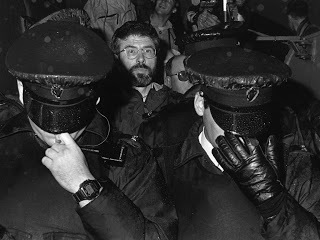
Me and Eamonn surrounded by the RUC on the Ormeau Bridge
After I was shot in 1984 the late Tom Cahill decided that I needed a driver.
Up until then there were about a dozen people at different times who I could get lifts from.
Eamonn was always reliable when I needed transport.
So Tom asked him to drive me on a fulltime, unwaged and voluntary basis.
Eamonn agreed and together for over seventeen years we travelled the length and breadth of this island and further afield.
Eamonn was Sinn Féin’s first security team.
It was a dangerous time and a dangerous job.
As well as the constant threat of assassination there was the daily gauntlet of RUC and British Army harassment.
The arrogant viciousness of RUC officers, UDR and British Army soldiers who at every opportunity and at every checkpoint, made threats and tried to intimidate us.
Sometimes we were three or four hours on the side of the road.
The arrival of Peter Hartley into our team increased the danger and many times Eamonn and I had to protect poor wee Brits from Peter.
Our adventures and our misadventures, were numerous.
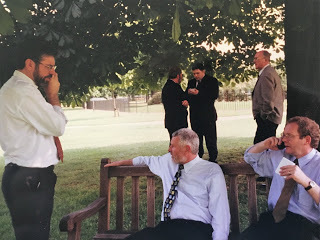 Mise agus Martin Ferris and Martin McGuinness in London with Eamonn looking after us
Mise agus Martin Ferris and Martin McGuinness in London with Eamonn looking after us
I have limited myself today to a few examples.
The first was when Eamonn was joined by Cleaky, Chink and Moke, Big Austin, Jamesy, Bernie, Murph, JimmyM, Mousey, Chico, and Gerard and others in providing security around the Sinn Féin negotiating team.
Cleaky had just been released from prison, he was under treatment for cancer, was asked to take charge of this.
He had few resources and almost no money.
Sinn Féin which was growing in strength was under constant attack, in our homes and offices.
Our members and family members were being killed.
And many were injured.
Cleaky’s skill as a scrounger was legendary.
Working with Big Eamonn and their small security team they liberated security doors, outside lights, inter-coms, security grills, toughened glass, bullet-proof vests and anything else that could save lives.
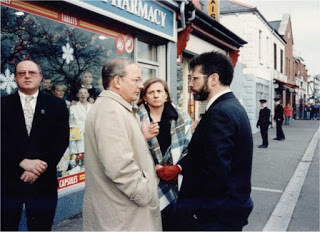
Big Eamonn keeping an eye on things as I spoke to US National Security Adviser Tony Lake, and Nancy Soderberg as we waited on the Falls for President Clinton in 1995
On one occasion, just before the first public engagement between Sinn Féin and the Brits, Cleaky secured ear pieces and microphones for personal radios for the security team.
There was only one problem Cleaky told Eamonn, before briefing the rest of the team.
The radios didn’t work. There were no transmitters.
But Cleaky explained to Eamonn that the appearance of having a very efficient security team could put off any would be attackers.
‘Ok’ said Eamonn.
So they pulled the rest of the team together and handed out the ear pieces and the microphones.
‘Put these down the sleeve of your coats’ Cleaky told them, and then speak into the microphone.
‘But there’s no transmitters,’ said Moke.
‘They don’t know that,’ said Eamonn.
‘But the radios aren’t working,’ said Moke.
Cleaky interrupted; ‘We’re going to have a visible presence at the meeting tomorrow. We will be a deterrent@.
So said Eamonn; ‘We have to look as if we know what we are doing. So, just let on the radios are working.’
‘Ok’ said Moke. ‘‘What’s my code name?’
‘What do you need a code name for’ said Cleaky. ‘The radios aren’t working’.
‘But we’re letting on they are. So we need code names.’
‘Ok said Eamonn. ‘Chucky number 1, Chucky number 2, Chucky number 3. Chucky number 4, Chucky number 5 …’
So, the next day when our delegation arrived at Parliament Buildings for negotiations with the British, Big Eamonn and the rest took up their positions, for all the world looking like US secret service agents talking to their sleeves.
The media and everyone else was hugely impressed.
There is old television footage of Cleaky talking into his sleeve.
But they didn’t know what he was saying.
‘Come in Chucky number 1 this is Up the Ra. Over and out mo chara’.
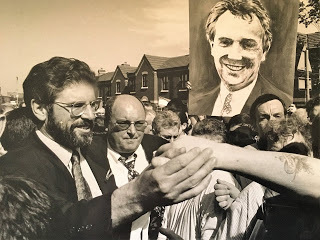 On another occasion, in November 1987 Eamonn was driving me and Danny Morrison back to Belfast.
On another occasion, in November 1987 Eamonn was driving me and Danny Morrison back to Belfast. We heard on the news that one of the H Block escapees Paul Kane was under siege by the Garda Special Branch in Cavan Town.
They were waiting for an extradition warrant.
Eamonn, Danny and I immediately headed for Cavan.
We picked up Paul and brought him to Brian McKeown’s home followed by the Garda Special Branch.
Then we decided to head for the border with Paul.
Now with hindsight that now seems a bit strange given that the state wanted to extradite Paul to the North.
However, our plan was that Danny Morrison would put on Paul’s coat.
Paul would put on my jacket.
And while Danny acted as a decoy and sprinted across the fields, Paul would sneak off.
That was the plan.
We clambered into the car.
Then Eamonn drove like a formula one racing driver down into Cavan Town chased by Garda cars, with lights blazing and sirens blaring.
It was like the Dukes of Hazzard.
Round and round we went before breaking for the border.
Eventually Eamonn screeched the car to a halt.
Danny the decoy jumped out.
He jumped over a hedge on the opposite side of the road and disappeared into a 15-foot deep sheough.
Paul exited left only to be wrestled to the ground by several Garda.
I lost my coat. Danny lost his shoes.
And Eamonn lost his driving licence after he and Paul were taken to Mountjoy Prison.
Paul was extradited to the North.
If he’s here today I would be really glad to get my jacket back.
My last story is a more tragic one.
After Mairead Farrell, Dan McCann and Sean Savage were executed by the SAS in Gibraltar Eamonn was part of the long journey home from Dublin airport to Belfast.
It took six and a half hours to reach the border where the RUC stopped us.
They wanted to hyjack the hearses. We wouldn’t let them.
There was standoff, during which we formed a convoy with our cars interspersed with the hearses.
Martin McGuinness was there and members of the McCann, Savage and Farrell families, along with other comrades.
Eventually we moved off again through Newry Town toward the MI.
The funeral cortege was attacked a number of times enroute.
But small groups of supporters also gathered at the crossroads to salute the Gibraltar martyrs.
And as we sped towards Belfast the RUC landrovers tried to force our cars out of the cortege.
We were surrounded on all sides by landrovers.
Inches separated Eamonn’s car from the armoured vehicles.
Eamonn drove mightily that night as he prevented the RUC from isolating the three hearses.
Eventually however we were forced off the road at Kennedy Way.
And what was the point in that exercise?
It was a futile effort by the RUC to pretend that they were in charge.
Because once they separated us from the hearses they allowed the hearses to proceed to the respective family homes.
Finally, one last story.
The roundabout beyond Sprucefield is known to us as Eamonn’s Roundabout.
One fateful night, very late as we were coming from Kerry, as we approached it I noticed that Eamonn wasn’t slowing down.
I knew we were in trouble when I heard him snoring.
‘Eamonn,’ I screamed.
And he woke up just as the car hit the roundabout and took off.
It was like an Evel Knievel stunt.
We almost cleared the roundabout and landed safely.
That was before mobile phones so my brother Dominic went off to get help.
The RUC arrived. They saw who we were and went off again.
I looked at Eamonn.
Eamonn looked at me.
‘Well’ he said. ‘I think I landed that very well.’
That was Eamonn.
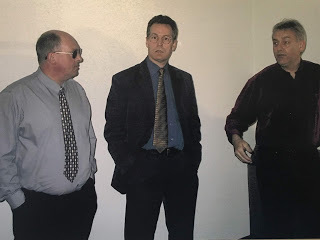
Eamonn and Gerry Kelly and Bik McFarlane in the Hospital cell in which Bobby died.
Our family, like most families, are doing our best to live lives rooted in decency, fairness and justice.
Eamonn and my lovely thoughtful sister Anne embodies that.
In their love for each other.
Their loyalty. Their love for family and community and Ireland.
In their humanity and compassion.
Their children, Eamonn, Fionnuala, Sean, and Bronagh are a credit to them.
I want to address my concluding remarks to their children to Anne and Eamonn’s grandchildren – to the future -; Eamonn óg, Ferghal – Ferghal has a big fight on Saturday night Eamonn will be in your corner - Áine, Conchur, the twins Caitlin and Tierna, the other twins Miceál and Deághlan, Cathal, Eimhear, Fiadh, Cormac, Sean Pearse, Oisín and their great -granddaughter Rionach.
You are Eamonn’s legacy.
When I see all you fine handsome young men and much smarter beautiful young women, I know the future is bright.
Those of you who are old enough will remember Eamonn.
He changed your nappies, cleaned your bums, wiped up after you.
He taught you to walk.
Did your homework with you.
Watched you playing sport.
He minded you when you were sick.
Scolded you when you needed scolding.
He lectured you when you messed up.
Then gave you the pocket money – when he had it – to allow you to mess up again.
And he defended you if your parents took exception to your occasional teenage misadventures.
Eamonn was quite rightly proud of you all.
Now some of the younger ones may not remember him.
Tell them about him.
Rionach is only nine months old. She won’t remember him.
So tell her and the other weans about their Daideo.
Let them know who he was.
What he and Granny Anne did for you all in your own personal lives, in that lovely subversive relationship, that good grandparents enjoy with their grandchildren.
All children need iconic figures who they can depend on.
Eamonn McCaughley was very dependable.
Tell them all of this and tell them before they were born that he fought for them and their future.
So that they will grow old in a free and united Ireland.
Tell them their Granda was in the Ra.
Tell them that he and Granny Anne were fighters for freedom.
Champions for rights.
Activists for equality.
So thank you Eamonn for your friendship; for your comradeship.
For all the adventures.
For all the miles on the road.
Thank you for minding me but especially thank you for minding my sister Anne and for leaving her so many wee McCaughley’s to mind her for you in the time ahead.
Go raibh mile maith aft Eamonn.
Slán Eamonn Mór.
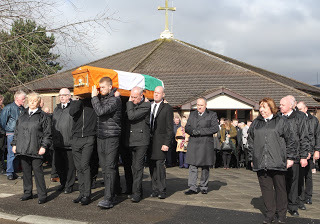
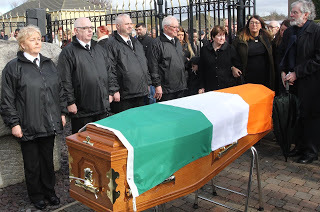
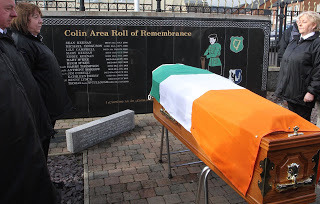
Published on March 08, 2019 03:33
February 28, 2019
The Springhill Massacre
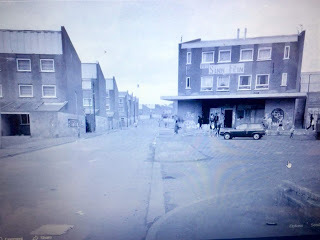
The Springhill estate in the 1980s
The Upper Springfield area of west Belfast suffered many traumatic events during the years of conflict. The area was the target of British military invasion and occupation, pogrom and refugees. Scores of its citizens were killed. Many more were injured. Hundreds spent years in British prison camps and gaols. The British Army used every weapon in its formidable arsenal to try and intimidate and terrorise the people of the Upper Springfield. Brutal beatings, the frequent use of CS gas, the indiscriminate firing of rubber and plastic bullets, arbitrary arrests and torture, were all part of the daily experience of the civilian population. So too were attacks by unionist death squads, working in collusion with, and under the cover of British Army and RUC actions.One legacy of this British government counter-insurgency strategy is currently playing out in a Belfast Coroners Court where 10 of the 11 citizens killed during the Ballymurphy Massacre in August 1971 are seeking the truth about the events surrounding the murder of their loved ones. 11 months later, on a bright Sunday evening on 9 July 1972, and just yards from the scene of the Ballymurphy Massacre, five more civilians were shot dead by British troops. That evening British Army snipers were hiding in what was then Corry’s timber yard overlooking the Springhill estate and the Westrock Bungalows. The Springhill estate and Westrock Bungalows represented some of the worst public housing existing at that time. The Springhill estate was a concrete, soulless estate with no public facilities. The Westrock Bungalows were temporary aluminium structures. They were built in the 1940s and 40 years later were still being used by large families. By then they were in a poor state of repair. The bungalows were cold, damp structures.The Springhill Massacre reflects in many ways the events the previous year in Ballymurphy. All those shot dead were civilians. The British claimed that the victims were gunmen or had been caught in crossfire during a gun battle. None of this was true. Three of those killed were children, one was a father of six and the last was the second priest from the greater Ballymurphy area to die in the conflict.
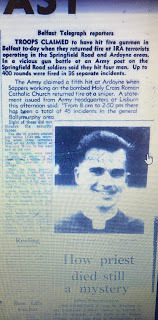 Belfast Telegraph report which presents British Army versionOn Tuesday evening in the Cultúrlann the families, their lawyer Pádraig Ó Muirigh, and prominent lawyer Michael Mansfield relaunched their campaign for truth. The families and other eye witnesses recounted the events of that evening in 1972.John Dougal who was aged 16 was the first to die. He was the eldest of eight children. He was shot as he tried to help others who had been shot. Margaret Gargan was 13 years old. She had been sitting talking with friends in the street when she was killed. One of her friend’s recalls: “We were only sitting talking, you know the way wee girls talk about things. Next thing she fell down. We never heard the shot. Within a couple of seconds, she was lying on the ground. It all happened so quickly. Then everybody started to scream.”Fr. Noel Fitzpatrick was a curate at St. John’s Church on the Falls Road but was based at Corpus Christi only a short distance from where he was shot dead. He had gone out to try and help a local man, Martin Dudley, who had been shot and wounded. He was shot through the neck.Paddy Butler was 38 and had six children. His son Eddie had been one of those shot and wounded during the Ballymurphy Massacre the previous August. Paddy had gone out with Fr. Fitzpatrick to help the wounded. Fr. Fitzpatrick was waving a white hanky. As they bent over the wounded man a bullet went through the priest’s neck and into Paddy’s head. Both died. The last victim was David (Dee) McCafferty who was 15 years old. He was with Fr. Fitzpatrick and Paddy Butler trying to help a wounded man. When Fr. Fitzpatrick was shot Dee tried to pull him to safety and was shot several times.Subsequently, forensic evidence showed that none of those killed or wounded were armed or had been in contact with any weapons. An RUC detective admitted that there was no investigation into the killings. The trauma for all of these families has continued for 47 years. In the years afterward it was especially difficult as the British Army and RUC often singled the relatives out for additional harassment. Paddy Butler’s daughter Jacqueline remembered that: “Although Daddy was an innocent man, because he had been shot by soldiers, the RUC raided our house every week after he died, ransacked it at four or five in the morning. Mum didn’t understand that either. She used to say, ‘How could they do that to us after killing Daddy?’ Every time there was a knock on the door, she would shudder and think of the day Daddy went out and never came back.”
Belfast Telegraph report which presents British Army versionOn Tuesday evening in the Cultúrlann the families, their lawyer Pádraig Ó Muirigh, and prominent lawyer Michael Mansfield relaunched their campaign for truth. The families and other eye witnesses recounted the events of that evening in 1972.John Dougal who was aged 16 was the first to die. He was the eldest of eight children. He was shot as he tried to help others who had been shot. Margaret Gargan was 13 years old. She had been sitting talking with friends in the street when she was killed. One of her friend’s recalls: “We were only sitting talking, you know the way wee girls talk about things. Next thing she fell down. We never heard the shot. Within a couple of seconds, she was lying on the ground. It all happened so quickly. Then everybody started to scream.”Fr. Noel Fitzpatrick was a curate at St. John’s Church on the Falls Road but was based at Corpus Christi only a short distance from where he was shot dead. He had gone out to try and help a local man, Martin Dudley, who had been shot and wounded. He was shot through the neck.Paddy Butler was 38 and had six children. His son Eddie had been one of those shot and wounded during the Ballymurphy Massacre the previous August. Paddy had gone out with Fr. Fitzpatrick to help the wounded. Fr. Fitzpatrick was waving a white hanky. As they bent over the wounded man a bullet went through the priest’s neck and into Paddy’s head. Both died. The last victim was David (Dee) McCafferty who was 15 years old. He was with Fr. Fitzpatrick and Paddy Butler trying to help a wounded man. When Fr. Fitzpatrick was shot Dee tried to pull him to safety and was shot several times.Subsequently, forensic evidence showed that none of those killed or wounded were armed or had been in contact with any weapons. An RUC detective admitted that there was no investigation into the killings. The trauma for all of these families has continued for 47 years. In the years afterward it was especially difficult as the British Army and RUC often singled the relatives out for additional harassment. Paddy Butler’s daughter Jacqueline remembered that: “Although Daddy was an innocent man, because he had been shot by soldiers, the RUC raided our house every week after he died, ransacked it at four or five in the morning. Mum didn’t understand that either. She used to say, ‘How could they do that to us after killing Daddy?’ Every time there was a knock on the door, she would shudder and think of the day Daddy went out and never came back.”
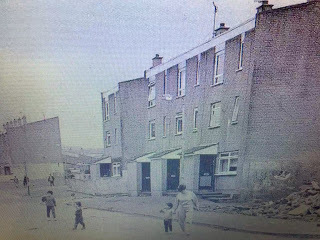
Like the Ballymurphy families the Springhill families have been campaigning for years for the truth. In December 2014 the Attorney General John Larkin agreed to the establishment of new inquests. In a letter to the family he said: “It seems to me that the truth about what happened in Springhill on 9 July 1972 is, at present, only likely to emerge through an inquest.”That was over four years ago. The decision by the families to relaunch their campaign at this time is because currently, due to a lack of funding for inquests, there appears little likelihood that the Springhill Inquests will be heard in the next few years. In 2016 the North’s Lord Chief Justice, Declan Morgan, proposed a plan to deal with all inquest cases within five years. It was blocked by Arlene Foster. Last year a Belfast Court ruled that Foster, as First Minister, unlawfully stopped a discussion at the Executive of the plan by the Lord Chief Justice. It was claimed that because the majority of the inquests relate to state killings that the DUP leader refused to allow an inquest process to go ahead which would "rewrite the past." The funding has been blocked since then. The Springhill families deserve support. They have demonstrated enormous courage and perseverance over almost 50 years. Writing last week in this paper Fr. Des Wilson put it well when he said:“There is still a long way to go to reveal the truth about what our neighbours suffered. It is worth the journey because one of our most heartening principles in the truth will set us free, and so it is the duty and privilege of us all to reveal it.”
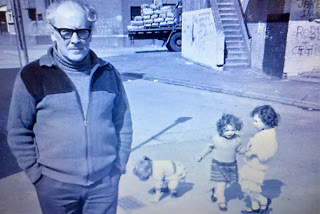
Fr. Des in Springhill
Published on February 28, 2019 03:08
February 22, 2019
No return to the status quo
Two weeks ago the British Secretary of State Karen Bradley emerged from the NIO Office in the Stormont Estate to tell us that the conditions for a referendum on unity, as set out in the Good Friday Agreement, have not been met.Three weeks earlier the same Secretary of State was reported in the London Times privately warning a British Cabinet meeting on 8 January that a no deal Brexit would make a referendum on Irish Unity “far more likely.”Last week the BBC reported that several British Cabinet Ministers had told it that a no-deal Brexit could lead to a vote on Irish unification. The BBC report said: “One senior minister said the prospect is "very real" and very much on the prime minister's mind. A second cabinet minister warned the government risked "sleepwalking into a border poll". And a third cabinet minister said there was an understanding in government that a vote on unification would be a "realistic possibility" if the UK leaves the EU without a deal next month. "If we are party to creating an environment of chaos, disruption and uncertainty - that could move the dial", the source said. All three spoke to the BBC on condition of anonymity.”What’s behind this sudden talking-up by British Ministers of the possibility of a referendum on Irish Unity? Do they believe it? Possibly. But more likely its part of a very blunt tactical approach by Downing Street to frighten and blackmail its own members to toe the leadership line on Brexit. Talk of a referendum on Irish Unity is an attempt to scare Tory backbenchers in the British Parliament into agreeing to May’s Brexit plan. At the same time Theresa May has written to all of her 316 MPs. She has appealed to them to support her Brexit deal warning that “history will judge us all.” With less just over 5 weeks to go before the March 29th deadline for Brexit the British Conservative government and Parliament continue to be as deeply divided as ever as a result of that government’s incompetence in managing the self-inflicted Brexit crisis.
Its ineptitude was also on display in Belfast last Friday when the British Secretary of State Karen Bradley, and Tánaiste Simon Coveney, met the five main parties at Stormont. According to Bradley it was about recommencing a talk’s process to restore the political institutions. It deservedly got short shrift from Mary Lou McDonald and Michelle O’Neill. Simon Coveney did less than well when he acquiesced to that pretence.
It’s just over two years since Martin McGuinness resigned as Deputy First Minister. In his letter of resignation Martin set out clearly the crisis facing the institutions as a result of the DUP handling of the RHI scandal and its behaviour within the institutions. Martin wrote on January 10th 2017: “The equality, mutual respect and all-Ireland approaches enshrined in the Good Friday Agreement have never been fully embraced by the DUP. Apart from the negative attitude to nationalism, and to the Irish identity and culture; there has been a shameful disrespect towards many other sections of our community. Women, the LGBT community and ethnic minorities have all felt this prejudice. And for those who wish to live their lives through the medium of Irish, elements in the DUP have exhibited the most crude and crass bigotry.
[image error] Over this period successive British governments have undermined the process of change by refusing to honour agreements, refusing to resolve the issues of the past while imposing austerity and Brexit against the wishes and best interests of people here. Against this backdrop the current scandal over the Renewable Heat Incentive (RHI) has emerged.”
This is the yardstick against which Sinn Féin and all of those democrats and progressives who seek to rebuild confidence and restore the institutions, will judge any talks process. The British and Irish governments need to be up to the task of substantially addressing the matters raised by Martin, especially the ongoing denial of rights enjoyed everywhere else on these islands. If they don’t, and if the DUP remains doggedly resistant to making progress on the issue of rights, then a talks process will fail before it begins.
Mary Lou and Michelle didn’t mince their words last Friday. They described Bradley’s intervention as cynical and lacking any credibility. They believe that the Conservative Party’s real agenda is about helping the DUP distract public attention away from DUP intransigence and the RHI scandal as the local government elections loom on the horizon.
The reality is that there is no tolerance – none – among nationalists and republicans for going back into political institutions which function as they did before. That is not acceptable. In the interviews he gave in his office after submitting his resignation letter Martin put it best when he said that there can be no going back to the status quo. He was right. He is right.
If the DUP or the Ulster Unionist Party want to be back in the Assembly exercising power and influence over government departments and policy then the price for that is the implementation of the Good Friday Agreement, and in particular the creation of laws which embrace every citizen on the basis of equality and parity of esteem.
Sinn Féin wants a functioning Assembly. An accountable and transparent Executive. We want local Ministers, accountable to local citizens, taking the decisions that impact on the daily lives of everyone living in this part of Ireland. We want an Assembly which is progressive, respectful, and has integrity. We do not want a sham talk’s process which cannot, will not, and is not designed to deliver progress on the issue of rights and the Good Friday Agreement. There can be, there will be, no return to the status quo.
Published on February 22, 2019 11:11
February 16, 2019
The Chieftain’s Walk.
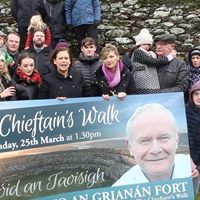
Back in the day I would be in Derry quite often for meetings, or unfortunately for funerals, and occasionally for social events. A wedding or a christening. Derry was a place apart. It generally didn’t have the omnipresent tension or threatening communal fragility of Belfast. If the British Army or the RUC weren’t on the streets of the West Bank there was a sense of tranquillity in that community. It was far from the beleaguered defensive streets of the Short Strand or the Ormeau Road. On the days like that Derry was not unlike Sligo or Drogheda. A picturesque Irish town nestled on the banks of the wonderful Foyle water.
Martin McGuinness was a child of that town. He was Derry to his core. Donegal was at his back above the heights of Creggan. That’s where his family came from. Na hUilli, anglicized to the Illies, north of Buncrana, on the Inis Eoghain peninsula. That’s where Martin spent his childhood summers. Bouncing high on turf stacked trailers along bog roads. Swatting midges and gathering hay or collecting hens eggs in his Granny’s place. Learning to fish. In the rain. Watching sunsets. And sunrises. Beach combing on wind lashed and wave battered deserted sea strands. Freedom!
When Martin and Bernie got married it was in Cockhill chapel, outside Buncrana that they made their wedding vows. It was there that Martin got Colette and I the use of a caravan for me to recuperate in after I was shot and wounded in 1984. So with the help and hospitality of the late Réamonn Mac Lochlainn - father of Pádraic, Jim Ferry and Eddie Fullerton I also got to know the magic of the Inis Eoghain peninsula. Eddie brought me to where he said Wolfe Tone landed on the Swilly and it wasn’t long before I was walking on the hills of that idyllic place.
Inis Eoghain and Derry are on opposite flanks of that same broad finger of high ground between the Swilly and the Foyle. The British border winds its invasive unwelcome way through this beautiful landscape creating two separate jurisdictions and separating County Derry from County Donegal. Martin used to joke that the only thing that kept Derry in the British state was the Craigavon Bridge. There is more than a grain of truth in that wry observation.
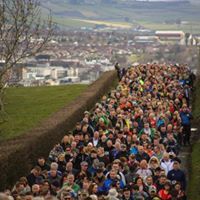 Occasionally Martin and I would walk out the Groarty Road to Grianán Ailigh. Or Grianán of Aileach - also known as Grianán Fort. This ancient stone built ring fort, founded in the sixth century or earlier, was one of his favourite places. It is one of the royal sites of Gaelic Ireland. Martin went there many times, including night times when the beautiful starlit Donegal skyscape is a wonder to behold. Or at sunset. So for me Grianán is forever tied up with Martin McGuinness.
Occasionally Martin and I would walk out the Groarty Road to Grianán Ailigh. Or Grianán of Aileach - also known as Grianán Fort. This ancient stone built ring fort, founded in the sixth century or earlier, was one of his favourite places. It is one of the royal sites of Gaelic Ireland. Martin went there many times, including night times when the beautiful starlit Donegal skyscape is a wonder to behold. Or at sunset. So for me Grianán is forever tied up with Martin McGuinness.After Martin’s death his family and friends organized a fundraiser for The North West Cancer Centre at Altnagelvin last March. It took the form of a sponsored walk to Grianán of Aileach from Derry. Siúlóid An Taoisigh -The Chieftains Walk.Three thousand people took part. All Martins clann were there led by Bernie the power walker. Over £30,000 was raised. Everyone who registered and did the walk got a commemorative medal to mark the event. It was a great day out.
I did the walk that day. Me and our dog Fionn and one of the little people in my life, Anna Nic Adhaimh. She was only eight years old. According to my Fitbit we walked eight and a half miles. According to the organizers it is five and a half miles from Glenowen in Derry to Grianán. That’s probably true but we also had to walk back to the car. Anna is a champion. The last few miles to Grianán are uphill. It is so steep Ted needed climbing ropes.
So this year the Chieftains Walk has been rerouted. This year its nearly all on the flat. Or so Andrew McCartney says. That’s Andrew who did last year’s Siúlóid in a minibus.
This year The Chieftains Walk will be on Sunday 24th March at 1.30 from Ebrington Square to the Ryan McBride Brandywell Stadium. All money raised will go to the Foyle Hospice and the ICU at Altnagelvin. It’s a three-mile route. It will leave Ebrington Square via the Peace Bridge and turn left along the Foyle Embankment and walk along Foyle Road. It will cross over the Foyle Road into the Brandywell and finish beside the Ryan Mc Bride Brandywell Stadium. As it enters into the Brandywell it will pass close to where Martin once lived in Southend Park.
Ebrington Square was formerly the parade ground of one of the largest British military installations in Derry. It was turned into a public space and tourist attraction as part of the peace process and is linked to the west bank of the city via the Peace Bridge. Martin was key to the development of both of these initiatives as well as the Brandywell stadium which was called after Ryan McBride, Derry City soccer star, who died the same week as Martin.
Ebrington Square was opened as a public space on Valentine’s Day 14 February 2012 and hosted a number of major events in 2013 as part of the year of City of Culture.
So, join us and Bernie and all the McGuinness clann in memory of Martin and in a good cause. You will enjoy the walk and the craic. Last year a woman beside me didn’t recognise me until she heard my voice. I was wearing sunglasses.
‘Jesus’ she exclaimed when she heard me talking ‘Its yourself. I thought you were a blind man with your Guide dog.’
Fionn was pleased. He’s a yellow Labrador. Anna thought it was funny. She’s going again this year. So is Fionn.
Bígí linn ar Siúlóid an Taoisigh.
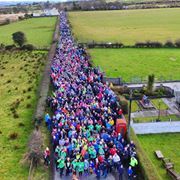
Published on February 16, 2019 03:17
Gerry Adams's Blog
- Gerry Adams's profile
- 29 followers
Gerry Adams isn't a Goodreads Author
(yet),
but they
do have a blog,
so here are some recent posts imported from
their feed.


